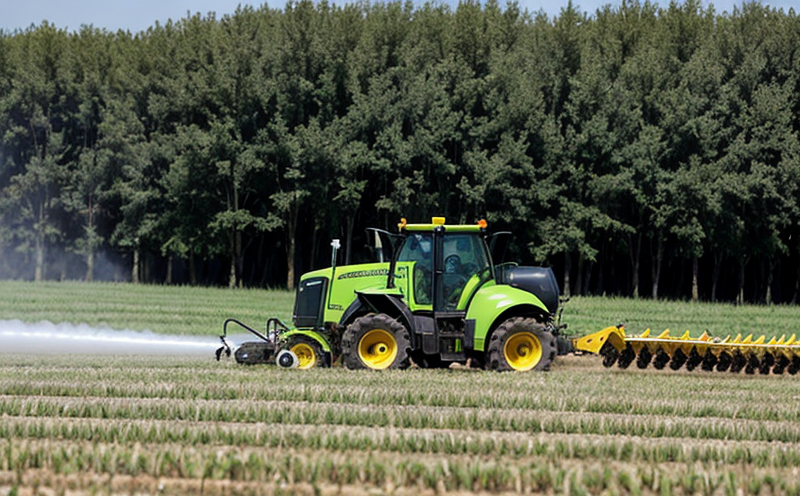Imazethapyr Residue Testing in Crops
Imazethapyr is a widely used herbicide that belongs to the imidazolinone family. It is effective against broadleaf weeds and grasses, making it an essential tool for agricultural management. However, the presence of residues in crops can pose significant risks to human health and the environment if not controlled properly. This service page provides comprehensive information on testing imazethapyr residues in crops, ensuring compliance with international standards and maintaining product quality.
Testing imazethapyr residues is critical for several reasons. First, it helps ensure that products are safe for consumption by humans and animals. Second, residue testing supports the implementation of Good Agricultural Practices (GAP) to enhance food safety and traceability. Third, accurate residue levels are vital for monitoring environmental impact and preventing contamination of water sources.
The process begins with sample collection from various parts of the crop, including leaves, stems, and seeds. Samples must be representative to ensure reliable results. Once collected, samples undergo thorough preparation steps such as drying, grinding, and sieving before extraction using appropriate solvents. The extracted residues are then analyzed using sophisticated analytical techniques like High-Performance Liquid Chromatography (HPLC) or Gas Chromatography-Mass Spectrometry (GC-MS). These methods provide precise quantification of imazethapyr levels.
The standard method for determining the acceptable limits is based on international standards such as ISO 13676:2004. According to this standard, the maximum residue limit (MRL) for imazethapyr in various crops should not exceed certain thresholds depending on the crop type and intended use.
Our laboratory employs rigorous quality control measures throughout every stage of testing. This includes using calibrated equipment, maintaining traceable calibration certificates, and ensuring personnel are trained according to ISO/IEC 17025 guidelines. Our commitment to accuracy is further demonstrated through regular participation in proficiency testing programs like those organized by AOAC International or other recognized bodies.
By providing accurate imazethapyr residue test results, we contribute significantly towards maintaining high standards of food safety and environmental protection. This service ensures that agricultural products meet regulatory requirements while also supporting sustainable farming practices.
Why It Matters
The importance of testing for imazethapyr residues cannot be overstated. Proper residue management is crucial not only from a legal perspective but also in terms of public health and environmental conservation.
- Legal Compliance: Regulatory bodies worldwide have established guidelines to regulate the use of pesticides like imazethapyr, including setting maximum allowable concentrations (MACs) for residues. Non-compliance can lead to product recalls, fines, or even bans on certain markets.
- Public Health: Prolonged exposure to high levels of pesticide residues has been linked to various health issues ranging from skin irritation to more severe conditions like cancer. Ensuring that food products contain acceptable levels helps protect consumers' well-being.
- Environmental Protection: Excessive use or improper disposal of pesticides can contaminate soil, water bodies, and air, leading to long-term ecological damage. By accurately measuring residues, we can identify areas where overapplication might occur and recommend corrective actions promptly.
In summary, residue testing plays a pivotal role in safeguarding both human health and the environment while upholding stringent quality standards within the agricultural sector.
Applied Standards
The application of internationally recognized standards is fundamental to our residue testing services. These guidelines ensure consistency across different laboratories, which is particularly important when dealing with global supply chains or international trade agreements.
- ISO 13676:2004: This standard specifies the general principles and procedures for determining maximum residue limits (MRLs) of pesticides in foodstuffs. It provides a framework that laboratories must follow when conducting tests, ensuring results are comparable globally.
- AOAC 989.06: Developed by the Association of Analytical Chemistry International, this method describes procedures for extracting imazethapyr from plant materials using solvent extraction followed by cleanup and quantification via GC-MS.
- USDA-NAL 3: Published by the National Agricultural Laboratory, this document outlines specific protocols for handling and analyzing samples containing trace amounts of pesticides. It emphasizes best practices to minimize contamination during sample preparation.
Our adherence to these standards guarantees that our findings are reliable, reproducible, and acceptable by regulatory authorities worldwide.
Quality and Reliability Assurance
To uphold the highest levels of quality assurance, we implement stringent processes at every step of the testing procedure. From sample collection to final analysis, each process is meticulously documented and reviewed to ensure accuracy and reliability.
- Calibration: All analytical instruments are regularly calibrated against certified reference materials according to ISO/IEC 17025 standards. Calibration certificates are maintained and updated annually.
- Traceability: Every measurement is traceable back to national or international standards through a chain of calibrations, ensuring that all results can be validated independently if necessary.
- Proficiency Testing: Our laboratory participates in external proficiency testing programs organized by recognized bodies such as AOAC International. These tests assess our performance against industry benchmarks and help identify any areas for improvement.
- Data Verification: After initial analysis, data is cross-checked using alternative methods whenever possible to verify results independently before reporting them officially.
This comprehensive approach ensures that all our clients receive accurate, trustworthy, and reliable residue testing services.





